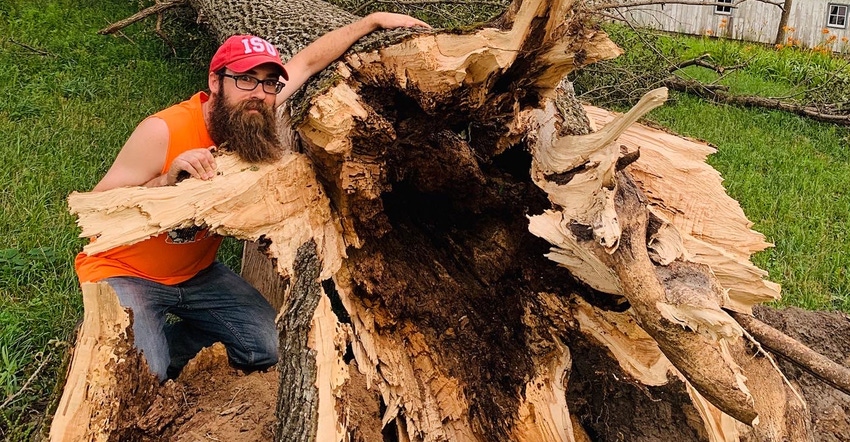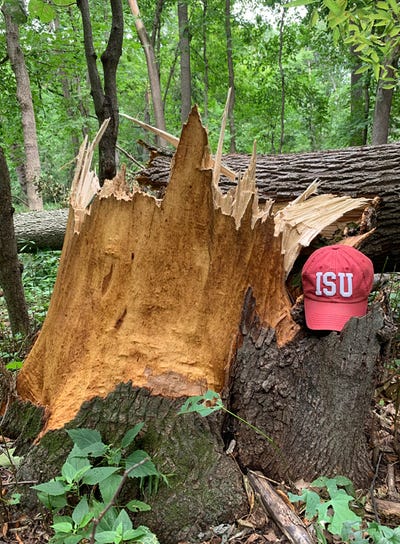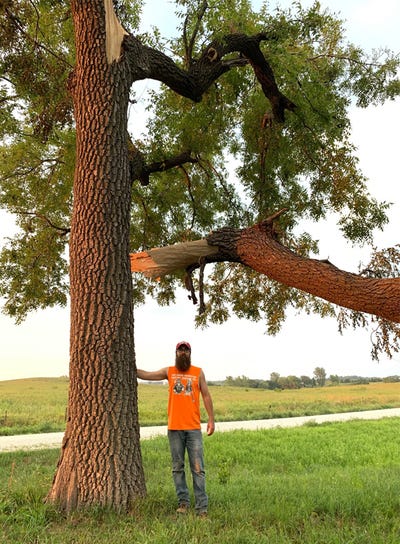September 21, 2020

In reviewing the damage, experts identified some common situations leading to failures. Among the top causes were poor pruning practices, trunk and limb damage from vehicles and equipment, and a mismatch between a tree species and its site.
Billy Beck, assistant professor and Extension forestry specialist at Iowa State University, recently shared his firsthand experience with the aftermath of the storm, highlighted the root causes of many tree failures, and shared insights on maintaining trees for vitality — the best way to weather future storms.
Beck’s big messages for response, recovery and planning are practice chain saw safety, assess and address, and match the species to the site.
Safety first — always
“In the aftermath of a storm like this, the first response is to make things safe; clear downed limbs and trees from structures, utility lines and roads; and relieve pressures that broken limbs may be placing on remaining healthy sections of a tree,” Beck says. “Unfortunately, the adrenaline associated with responding to an emergency can pose additional risks to individuals after the wind stops blowing. I always stress safety in all activities around broken and downed trees.”
Beck expressed great concern for the health and safety of landowners and everyday folks trying to help clear the damage using chainsaws and equipment with which they may have little or no experience.
 CLEANING UP: ISU’s Billy Beck recommends selectively removing, pruning and trimming injured trees in early winter, or at least before spring.
CLEANING UP: ISU’s Billy Beck recommends selectively removing, pruning and trimming injured trees in early winter, or at least before spring.

“Working with chain saws can turn disastrous in the blink of an eye, particularly when dealing with a tangle of downed limbs and trees,” Beck says. “To an inexperienced or unpracticed eye, it is easy to overlook the intense hidden dangers of crossed branches and unstable footholds that can quickly lead to injuries.”
He further recommends frequent breaks, understanding your skill level and personal limitations, and getting help from professionals when the needs outstrip your capabilities. Professional foresters, certified arborists and tree maintenance providers conduct business throughout Iowa, and all have the expertise and equipment to assist landowners in different situations.
Professional help available
ISU Extension maintains a list of consulting certified arborists and public forestry contacts by county at ISU Extension. Beck says a list of private consulting foresters is also being compiled. These very same professionals can help with the recovery and planning stages after a storm. The first step is to assess what is left and make a plan for recovery.
“A certified arborist will have the practiced eye necessary to assess damage and weaknesses that may not be apparent to a homeowner or landowner,” Beck says. “Assessments of tree health and vigor will help predict how a tree will fare in future storms. For example, a slow response to wounding increases susceptibility to disease and insect damage, which will weaken the tree.
“On my property, which I recently acquired, I lost trees that had suffered repeated damage from farm equipment and others in which improper pruning most likely led to poor healing, which contributed to hollowed trunks,” he adds. “From the outside, these trees appeared robust, but without a stable trunk, they came down in a hurry.”
Some trees more susceptible
In addition to physical damage and weakness from insects and disease, some trees simply do not thrive in every location. This is particularly evident in urban settings where compacted soil and adjacent hardscapes and pavement can constrict root growth.
Incompatibility between multiple species and urban planting sites contributed to many downed trees during the storm. While they are vigorous trees along streams and in rural areas, trees such as silver maple, elm, hackberry, green ash and cottonwood were hit hard in urban settings. While some of these trees may be more prone to wind damage, the potential appears to be greater in urban settings.
 MATCH SPECIES TO SITE: When selecting replacement trees, plant those that will grow well in a site’s unique conditions.
MATCH SPECIES TO SITE: When selecting replacement trees, plant those that will grow well in a site’s unique conditions.

“In general, fast-growing species with lower-strength wood and loose grain and tight crotches will be most susceptible to wind damage. But when planted in stressful environments, which do not allow proper root health or access to needed nutrition and water, failure is even more likely,” Beck says. “When selecting replacement trees, it’s critical to assess the planting site and select from trees that will grow well under the site conditions. This approach will help ensure a healthy vigorous tree, which will be most resistant to future damage.”
Planting replacement trees
When in doubt, Beck recommends employing the services of an arborist to assist with selecting appropriate replacement trees that are best-suited to the site.
Rural landowners and farmers assessing damage to woodlands face a more complex situation than urban dwellers. With larger areas comprised of multiple species and the potential for unseen damage or suspended limbs, consulting with a forester is the recommended course of action.
“The best first stop is a USDA service center to obtain assistance and advice on how to best and most safely proceed with assessing and cleaning up damage to a forestland,” Beck says. “At the service center, you can also learn about the availability of potential cost-share programs and other assistance such as advice on creating a plan for recovery and future plantings.”
Repairing damage, taking inventory
As winter approaches and the leaves fall, unseen damage will become more evident. Addressing damage is important to complete before winter storms can compound any issues. Beck recommends surveying and selectively removing, pruning and trimming trees in early winter, or at least before spring, to promote healthy growth and ensure more resilient forests and woodlands going forward.
“While you are out surveying damage, it’s a good idea to complete an inventory of the trees on the property,” Beck says. “Knowing what trees are growing and the relative health of each can provide input to a forest management plan and provide insights to the value of any timber that may be harvested in the future.”
He also suggests that rural landowners with damaged woodlands visit with the Farm Service Agency representative in their USDA service center to inquire about eligibility for the Emergency Forest Restoration Program, a cost-share program to improve forest resiliency.
“While the program is not currently available in Iowa, the unprecedented damage from the derecho and additional requests for support might influence FSA to consider expanding the program to include Iowa’s woodlands,” Beck says.
Read Beck’s blog about the derecho. The blog also has reference links to multiple resources on proper tree pruning, planting and care.
Chain saw safety
Beck stresses the need for appropriate clothing and safety practices when using a chain saw. These include goggles or a face shield, hearing protection, hard hat, heavy leather gloves, sturdy footwear steel-toed preferred — and chain saw chaps, an absolute must. Understanding where cut limbs will fall, maintaining a clear work zone, working at a safe level and finding stable footing are basic imperatives to avoiding injury.
He cites the mental and physical endurance needed for this type of work. “It’s very easy to overexert yourself, wanting to finish the job or cut one more limb, and lose focus or concentration to exhaustion. Working in a dangerous environment, doing unfamiliar work that tests the strength and endurance of any individual, and being chock-full of adrenaline are not the best conditions for making good and safe decisions.”
Ripley is an Iowa Learning Farms conservation outreach specialist.
About the Author(s)
You May Also Like




